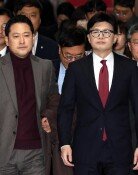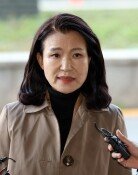New Data Unearthed on Last Empress` Assassination
New Data Unearthed on Last Empress` Assassination
Posted January. 11, 2010 08:16,
On Oct. 8, 1895, unidentified assailants jumped over the wall of Seouls Gyeongbok Palace at 5:30 a.m. and opened the gate Gwanghwamun. This allowed dozens of additional assailants to enter.
They rushed to Geoncheonggung at the palaces northern end to throw into chaos Jangandang, the residence of the last monarch of the Joseon Dynasty King Gojong, and Gonnyeonghap, the residence of Queen Myeongseong.
The king and court ladies were at a loss as the assailants loudly announced Prince Regent Heungseon Daewonguns appearance at the palace. By taking advantage of the confusion, the assailants intruded into Gonnyeonghap. King Gojong blocked them from reaching the floor of his residence, but they pushed him down.
At that moment, the queen and court ladies appeared at the corridor linked to Jangandang. When they reached the floor through a narrow corridor, one of the assailants grabbed the queen by the back of her neck. He took her to the backyard and killed her with a sword.
The man who wielded the sword was identified as Daketaro Miyamoto, a second lieutenant of the Japanese Army. This means the Japanese military, which took orders from its emperor, ordered the assassination of the queen. Her murder is also known as the Eulmi Incident.
○ Japanese military ordered queens murder
The assailants moved the queens body to Okhoru at Gonnyeonghap to confirm her identity with her picture and cremate the body at Noksan near Gonnyeonghap.
Korean-Japanese historian Kim Moon-ja wrote in her book The Murder of the Joseon Queen and the Japanese People that Daebonyeong, the Japanese army headquarters in Korea, ordered her murder according to Japanese military documents.
Though eight Japanese army officers took the lead in the assassination, the Japanese government called her murder an act committed by merchants or wanderers.
○ Japan began aggression with Unyo-ho Incident
Japanese aggression toward Korea dates back to 1875, the year of the Unyo-ho Incident, or an armed encounter between the Joseon Dynasty and Japan in the vicinity of Ganghwa Island. After setting up Meiji as the emperor, Japanese reformers established a navy and started an armed conflict by sending the naval vessel Unyo into Korean waters following a similar incident in Taiwan in 1874.
In 2002, the initial report by the ships captain, which had been buried deep in a document library at Japans Defense Agency, was made public both in Seoul and Tokyo at the same time through a thesis. The report said what has been known so far about the incident is a lie.
In contrast to what Japan argued, the ship did not fly the Japanese flag. So the report saying the Joseon artillery corps fired at the ship was legitimate. Then Japans Foreign Ministry called in the captain and had him manipulate the report in preparation for scrutiny of the incident by western diplomats in Tokyo. The fake report said the ship entered Korean waters with its national flag flying to secure water on its way to Liaoning, China.
○ Intrusion into palace before Sino-Japanese War
For its war with China, Japan reformed its draft system in 1889 and drastically expanded its number of soldiers from 30,000 to 360,000.
In the name of suppressing a peasants uprising in Korea in the summer of 1894, Japan dispatched its troops there. Some 8,000 Japanese soldiers, however, headed toward Seoul, not Jeonju, North Jeolla Province, where the uprising took place. This was to urge the Korean government to reform as a fundamental solution to the uprising.
The Korean government refused, however. Japan repeatedly lobbied King Gojong, but when no progress was made, Japanese soldiers surrounded Gyeongbok Palace at midnight. Dozens of them forced their way into the palace and nearly captured the king.
○ Preparation for war against China
When Japan dispatched its troops on June 5, 1894, it set up Daebonyeong to prepare for war with China. In April 1895, Japan won the Sino-Japanese War but did not withdraw its troops from Korea after the conflict ended.
Certain Japanese military leaders wanted to leave a military force in Korea to maintain electrical lines, but King Gojong and the queen demanded an outright withdrawal. To this, Daebonyeong appointed Lt. Gen. Goro Miura as the Japanese minister to Joseon and ordered him to murder the queen.
A series of events before and after the assassination was clearly perpetrated by the Japanese military. The weakening of national power in Korea led to the countrys oppressive colonization by Japan.





![[단독]“권성동, ‘王’자 노리개 등 장식 상자 2개로 1억 받았다”](https://dimg.donga.com/c/138/175/90/1/wps/NEWS/IMAGE/2026/01/22/133211754.1.jpg)

